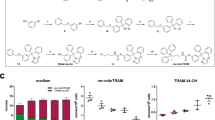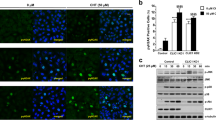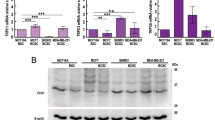Abstract
The critical role of calcium signalling in processes related to cancer cell proliferation and invasion has seen a focus on pharmacological inhibition of overexpressed ion channels in specific cancer subtypes as a potential therapeutic approach. However, despite the critical role of calcium in cell death pathways, pharmacological activation of overexpressed ion channels has not been extensively evaluated in breast cancer. Here we define the overexpression of transient receptor potential vanilloid 4 (TRPV4) in a subgroup of breast cancers of the basal molecular subtype. We also report that pharmacological activation of TRPV4 with GSK1016790A reduced viability of two basal breast cancer cell lines with pronounced endogenous overexpression of TRPV4, MDA-MB-468 and HCC1569. Pharmacological activation of TRPV4 produced pronounced cell death through two mechanisms: apoptosis and oncosis in MDA-MB-468 cells. Apoptosis was associated with PARP-1 cleavage and oncosis was associated with a rapid decline in intracellular ATP levels, which was a consequence of, rather than the cause of, the intracellular ion increase. TRPV4 activation also resulted in reduced tumour growth in vivo. These studies define a novel therapeutic strategy for breast cancers that overexpress specific calcium permeable plasmalemmal ion channels with available selective pharmacological activators.
This is a preview of subscription content, access via your institution
Access options
Subscribe to this journal
Receive 50 print issues and online access
$259.00 per year
only $5.18 per issue
Buy this article
- Purchase on Springer Link
- Instant access to full article PDF
Prices may be subject to local taxes which are calculated during checkout






Similar content being viewed by others
References
Aydar E, Yeo S, Djamgoz M, Palmer C . Abnormal expression, localization and interaction of canonical transient receptor potential ion channels in human breast cancer cell lines and tissues: a potential target for breast cancer diagnosis and therapy. Cancer Cell Int 2009; 9: 23.
Ding X, He Z, Zhou K, Cheng J, Yao H, Lu D et al. Essential role of TRPC6 channels in G2/M phase transition and development of human glioma. J Natl Cancer Inst 2010; 102: 1052–1068.
Zhuang L, Peng JB, Tou L, Takanaga H, Adam RM, Hediger MA et al. Calcium-selective ion channel, CaT1, is apically localized in gastrointestinal tract epithelia and is aberrantly expressed in human malignancies. Lab Invest 2002; 82: 1755–1764.
Yang SL, Cao Q, Zhou KC, Feng YJ, Wang YZ . Transient receptor potential channel C3 contributes to the progression of human ovarian cancer. Oncogene 2009; 28: 1320–1328.
Czifra G, Varga A, Nyeste K, Marincsak R, Toth BI, Kovacs I et al. Increased expressions of cannabinoid receptor-1 and transient receptor potential vanilloid-1 in human prostate carcinoma. J Cancer Res Clin Oncol 2009; 135: 507–514.
Monteith GR, Davis FM, Roberts-Thomson SJ . Calcium channels and pumps in cancer: changes and consequences. J Biol Chem 2012; 287: 31666–31673.
Chen R, Zeng X, Zhang R, Huang J, Kuang X, Yang J et al. Cav1.3 channel alpha1D protein is overexpressed and modulates androgen receptor transactivation in prostate cancers. Urol Oncol 2014; 32: 524–536.
Peters AA, Simpson PT, Bassett JJ, Lee JM, Da Silva L, Reid LE et al. Calcium channel TRPV6 as a potential therapeutic target in estrogen receptor-negative breast cancer. Mol Cancer Ther 2012; 11: 2158–2168.
Berridge MJ, Lipp P, Bootman MD . The versatility and universality of calcium signalling. Nat Rev Mol Cell Biol 2000; 1: 11–21.
Berridge MJ, Bootman MD, Roderick HL . Calcium signalling: dynamics, homeostasis and remodelling. Nat Rev Mol Cell Biol 2003; 4: 517–529.
Dubois C, Vanden Abeele F, Lehen'kyi V, Gkika D, Guarmit B, Lepage G et al. Remodeling of channel-forming ORAI proteins determines an oncogenic switch in prostate cancer. Cancer Cell 2014; 26: 19–32.
Feng M, Grice DM, Faddy HM, Nguyen N, Leitch S, Wang Y et al. Store-independent activation of Orai1 by SPCA2 in mammary tumors. Cell 2010; 143: 84–98.
Middelbeek J, Kuipers AJ, Henneman L, Visser D, Eidhof I, van Horssen R et al. TRPM7 is required for breast tumor cell metastasis. Cancer Res 2012; 72: 4250–4261.
Rivenbark AG, O'Connor SM, Coleman WB . Molecular and cellular heterogeneity in breast cancer: challenges for personalized medicine. Am J Pathol 2013; 183: 1113–1124.
Yang S, Zhang JJ, Huang XY . Orai1 and STIM1 are critical for breast tumor cell migration and metastasis. Cancer Cell 2009; 15: 124–134.
Pinton P, Giorgi C, Siviero R, Zecchini E, Rizzuto R . Calcium and apoptosis: ER-mitochondria Ca2+ transfer in the control of apoptosis. Oncogene 2008; 27: 6407–6418.
Trump BF, Berezesky IK, Chang SH, Phelps PC . The pathways of cell death: oncosis, apoptosis, and necrosis. Toxicol Pathol 1997; 25: 82–88.
Majno G, Joris I . Apoptosis, oncosis, and necrosis. An overview of cell death. Am J Pathol 1995; 146: 3–15.
Hartley DM, Kurth MC, Bjerkness L, Weiss JH, Choi DW . Glutamate receptor-induced 45Ca2+ accumulation in cortical cell culture correlates with subsequent neuronal degeneration. J Neurosci 1993; 13: 1993–2000.
Sattler R, Tymianski M . Molecular mechanisms of glutamate receptor-mediated excitotoxic neuronal cell death. Mol Neurobiol 2001; 24: 107–129.
Lee WH, Choong LY, Mon NN, Lu S, Lin Q, Pang B et al. TRPV4 regulates breast cancer cell extravasation, stiffness and actin cortex. Sci Rep 2016; 6: 27903.
Franken J, Uvin P, De Ridder D, Voets T . TRP channels in lower urinary tract dysfunction. Br J Pharmacol 2014; 171: 2537–2551.
Thorneloe KS, Cheung M, Bao W, Alsaid H, Lenhard S, Jian MY et al. An orally active TRPV4 channel blocker prevents and resolves pulmonary edema induced by heart failure. Sci Transl Med 2012; 4: 159ra148.
Adapala RK, Thoppil RJ, Ghosh K, Cappelli HC, Dudley AC, Paruchuri S et al. Activation of mechanosensitive ion channel TRPV4 normalizes tumor vasculature and improves cancer therapy. Oncogene 2016; 35: 314–322.
Thorneloe KS, Sulpizio AC, Lin Z, Figueroa DJ, Clouse AK, McCafferty GP et al. N-((1 S)-1-{[4-((2 S)-2-{[(2,4-dichlorophenyl)sulfonyl]amino}-3-hydroxypropanoyl)-1-piperazinyl]carbonyl}-3-methylbutyl)-1-benzothiophene-2-carboxamide (GSK1016790A), a novel and potent transient receptor potential vanilloid 4 channel agonist induces urinary bladder contraction and hyperactivity: Part I. J Pharmacol Exp Ther 2008; 326: 432–442.
Jo AO, Lakk M, Frye AM, Phuong TT, Redmon SN, Roberts R et al. Differential volume regulation and calcium signaling in two ciliary body cell types is subserved by TRPV4 channels. Proc Natl Acad Sci USA 2016; 113: 3885–3890.
Weerasinghe P, Buja LM . Oncosis: an important non-apoptotic mode of cell death. Exp Mol Pathol 2012; 93: 302–308.
Del Nagro C, Xiao Y, Rangell L, Reichelt M, O'Brien T . Depletion of the central metabolite NAD leads to oncosis-mediated cell death. J Biol Chem 2014; 289: 35182–35192.
Goldsby RA, Heytler PG . Uncoupling of oxidative phosphorylation by carbonyl cyanide phenylhydrazones. Ii. Effects of carbonyl cyanide M-chlorophenylhydrazone on mitochondrial respiration. Biochemistry 1963; 2: 1142–1147.
Cardaci S, Desideri E, Ciriolo MR . Targeting aerobic glycolysis: 3-bromopyruvate as a promising anticancer drug. J Bioenerg Biomembr 2012; 44: 17–29.
Gradilone SA, Masyuk TV, Huang BQ, Banales JM, Lehmann GL, Radtke BN et al. Activation of Trpv4 reduces the hyperproliferative phenotype of cystic cholangiocytes from an animal model of ARPKD. Gastroenterology 2010; 139: 304–314 e302.
Willette RN, Bao W, Nerurkar S, Yue TL, Doe CP, Stankus G et al. Systemic activation of the transient receptor potential vanilloid subtype 4 channel causes endothelial failure and circulatory collapse: part 2. J Pharmacol Exp Ther 2008; 326: 443–452.
Garcia-Elias A, Mrkonjic S, Jung C, Pardo-Pastor C, Vicente R, Valverde MA . The TRPV4 channel. Handb Exp Pharmacol 2014; 222: 293–319.
Laing RJ, Dhaka A . ThermoTRPs and pain. Neuroscientist 2016; 22: 171–187.
Shi Y, Ding X, He ZH, Zhou KC, Wang Q, Wang YZ . Critical role of TRPC6 channels in G2 phase transition and the development of human oesophageal cancer. Gut 2009; 58: 1443–1450.
El Boustany C, Bidaux G, Enfissi A, Delcourt P, Prevarskaya N, Capiod T . Capacitative calcium entry and transient receptor potential canonical 6 expression control human hepatoma cell proliferation. Hepatology 2008; 47: 2068–2077.
Zhang L, Barritt GJ . Evidence that TRPM8 is an androgen-dependent Ca2+ channel required for the survival of prostate cancer cells. Cancer Res 2004; 64: 8365–8373.
Mahieu F, Owsianik G, Verbert L, Janssens A, De Smedt H, Nilius B et al. TRPM8-independent menthol-induced Ca2+ release from endoplasmic reticulum and Golgi. J Biol Chem 2007; 282: 3325–3336.
Arundine M, Tymianski M . Molecular mechanisms of calcium-dependent neurodegeneration in excitotoxicity. Cell Calcium 2003; 34: 325–337.
Choi DW . Excitotoxic cell death. J Neurobiol 1992; 23: 1261–1276.
Wojda U, Salinska E, Kuznicki J . Calcium ions in neuronal degeneration. IUBMB Life 2008; 60: 575–590.
Zong WX, Thompson CB . Necrotic death as a cell fate. Genes Dev 2006; 20: 1–15.
Berridge MJ, Bootman MD, Lipp P . Calcium—a life and death signal. Nature 1998; 395: 645–648.
Frandsen SK, Gissel H, Hojman P, Tramm T, Eriksen J, Gehl J . Direct therapeutic applications of calcium electroporation to effectively induce tumor necrosis. Cancer Res 2012; 72: 1336–1341.
Pollack JR, Sorlie T, Perou CM, Rees CA, Jeffrey SS, Lonning PE et al. Microarray analysis reveals a major direct role of DNA copy number alteration in the transcriptional program of human breast tumors. Proc Natl Acad Sci USA 2002; 99: 12963–12968.
Solvang HK, Lingjaerde OC, Frigessi A, Borresen-Dale AL, Kristensen VN . Linear and non-linear dependencies between copy number aberrations and mRNA expression reveal distinct molecular pathways in breast cancer. BMC Bioinformatics 2011; 12: 197.
Cancer Genome Atlas N.. Comprehensive molecular portraits of human breast tumours. Nature 2012; 490: 61–70.
Klijn C, Durinck S, Stawiski EW, Haverty PM, Jiang Z, Liu H et al. A comprehensive transcriptional portrait of human cancer cell lines. Nat Biotechnol 2015; 33: 306–312.
Li B, Dewey CN . RSEM: accurate transcript quantification from RNA-Seq data with or without a reference genome. BMC Bioinform 2011; 12: 323.
Langfelder P, Horvath S . WGCNA: an R package for weighted correlation network analysis. BMC Bioinform 2008; 9: 559.
Clarke C, Madden SF, Doolan P, Aherne ST, Joyce H, O'Driscoll L et al. Correlating transcriptional networks to breast cancer survival: a large-scale coexpression analysis. Carcinogenesis 2013; 34: 2300–2308.
Haas BE, Horvath S, Pietilainen KH, Cantor RM, Nikkola E, Weissglas-Volkov D et al. Adipose co-expression networks across Finns and Mexicans identify novel triglyceride-associated genes. BMC Med Genomics 2012; 5: 61.
Presson AP, Yoon NK, Bagryanova L, Mah V, Alavi M, Maresh EL et al. Protein expression based multimarker analysis of breast cancer samples. BMC Cancer 2011; 11: 230.
Eisen MB, Spellman PT, Brown PO, Botstein D . Cluster analysis and display of genome-wide expression patterns. Proc Natl Acad Sci USA 1998; 95: 14863–14868.
Aung CS, Ye W, Plowman G, Peters AA, Monteith GR, Roberts-Thomson SJ . Plasma membrane calcium ATPase 4 and the remodeling of calcium homeostasis in human colon cancer cells. Carcinogenesis 2009; 30: 1962–1969.
Wu TT, Peters AA, Tan PT, Roberts-Thomson SJ, Monteith GR . Consequences of activating the calcium-permeable ion channel TRPV1 in breast cancer cells with regulated TRPV1 expression. Cell Calcium 2014; 56: 59–67.
Curry MC, Luk NA, Kenny PA, Roberts-Thomson SJ, Monteith GR . Distinct regulation of cytoplasmic calcium signals and cell death pathways by different plasma membrane calcium ATPase isoforms in MDA-MB-231 breast cancer cells. J Biol Chem 2012; 287: 28598–28608.
Azimi I, Beilby H, Davis FM, Marcial DL, Kenny PA, Thompson EW et al. Altered purinergic receptor-Ca(2)(+) signaling associated with hypoxia-induced epithelial-mesenchymal transition in breast cancer cells. Mol Oncol 2016; 10: 166–178.
Acknowledgements
This work was supported by the National Health and Medical Research Council of Australia (1079671) and Cancer Council Queensland (1042819). We are grateful to Sunil Lakhani and The Brisbane Breast Bank (The University of Queensland Centre for Clinical Research, Brisbane, Australia) for providing the MDA-MB-468 and BT-20 cell lines and RNA from 184A1, 184B5, MCF10A and Bre-80-hTERT cells for this study. GM is supported by the Mater Foundation. The Translational Research Institute is supported by a grant from the Australian Government. SYNJ was funded by the Ministry of Higher Education Malaysia Scholarship. ED is the recipient of a NBCF fellowship (ECR13-04).
Author information
Authors and Affiliations
Corresponding author
Ethics declarations
Competing interests
GRM and SJR-T are associated with QUE-Oncology Inc.
Additional information
Supplementary Information accompanies this paper on the Oncogene website
Supplementary information
Rights and permissions
About this article
Cite this article
Peters, A., Jamaludin, S., Yapa, K. et al. Oncosis and apoptosis induction by activation of an overexpressed ion channel in breast cancer cells. Oncogene 36, 6490–6500 (2017). https://doi.org/10.1038/onc.2017.234
Received:
Revised:
Accepted:
Published:
Issue Date:
DOI: https://doi.org/10.1038/onc.2017.234
This article is cited by
-
Matrix stiffness affects tumor-associated macrophage functional polarization and its potential in tumor therapy
Journal of Translational Medicine (2024)
-
The role of TRPV4 in programmed cell deaths
Molecular Biology Reports (2024)
-
Circulating tumor nucleic acids: biology, release mechanisms, and clinical relevance
Molecular Cancer (2023)
-
Targeting extracellular matrix stiffness and mechanotransducers to improve cancer therapy
Journal of Hematology & Oncology (2022)
-
Potent antitumor activity of a glutamyltransferase-derived peptide via an activation of oncosis pathway
Scientific Reports (2021)



